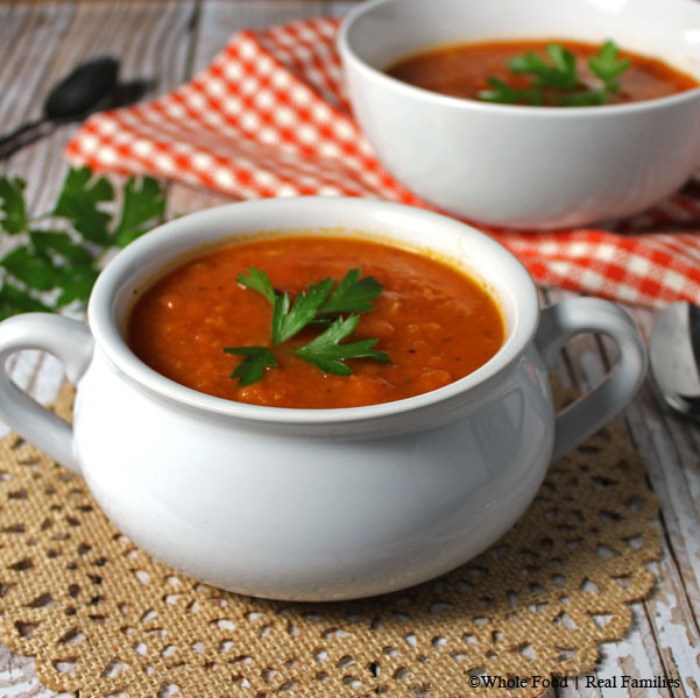Homemade Tomato Soup: A Culinary Delight
Recipe for homemade tomato soup – The comforting warmth of a bowl of tomato soup, its vibrant color and rich flavor, evokes feelings of nostalgia and home-cooked goodness. While store-bought versions offer convenience, nothing quite compares to the depth and freshness achieved through a homemade recipe. This guide will take you through crafting your own perfect bowl of tomato soup, from selecting the finest ingredients to mastering the art of simmering for optimal flavor.
A Brief History and Advantages of Homemade Tomato Soup
Tomato soup’s journey began centuries ago, with early versions differing significantly from the smooth, creamy concoction we know today. The modern iteration emerged with advancements in food processing and canning. Making tomato soup at home offers numerous benefits. You control the ingredients, ensuring freshness and avoiding preservatives, artificial colors, and excessive sodium often found in store-bought varieties. Furthermore, homemade soup allows for customization, enabling you to tailor the flavor profile to your exact preferences.
Three key reasons why homemade tomato soup surpasses store-bought options include superior taste, complete ingredient control, and the inherent satisfaction of creating something delicious from scratch. The fresh, vibrant flavor of homegrown or high-quality tomatoes simply cannot be replicated by mass-produced versions.
Crafting a delicious homemade tomato soup is surprisingly straightforward; simply roasting the tomatoes beforehand elevates the flavor significantly. For inspiration beyond the basics, you might find some interesting variations by checking out websites featuring panera soup recipes , which often include unique twists on classic soups. Then, apply those creative ideas to your own tomato soup recipe for a truly personalized culinary experience.
Ingredient Selection and Preparation

Source: pinchofyum.com
Choosing the right tomatoes is paramount to achieving a rich and flavorful soup. Heirloom varieties, with their diverse colors and intense flavors, are excellent choices. Roma tomatoes, known for their meaty texture and low water content, are also ideal. Canned tomatoes offer convenience, but fresh tomatoes provide a superior depth of flavor and a brighter, more vibrant color.
| Tomato Variety | Flavor Profile | Texture | Suitability for Soup |
|---|---|---|---|
| Heirloom | Complex, sweet, tangy | Variable, often meaty | Excellent |
| Roma | Rich, slightly acidic | Meaty, low water content | Excellent |
| Cherry | Sweet, slightly tart | Firm | Good (best roasted) |
| Canned (diced or crushed) | Consistent, slightly acidic | Soft | Convenient, but less flavorful |
Preparing the tomatoes involves washing, and then either chopping or roasting. Roasting enhances their sweetness and complexity. For roasting, toss halved or quartered tomatoes with olive oil, salt, and pepper, then roast at 400°F (200°C) for 30-40 minutes, until softened and slightly caramelized.
Recipe Variations and Flavor Profiles
The beauty of homemade tomato soup lies in its versatility. Adding ingredients like basil, oregano, thyme, or cream can dramatically alter the flavor profile. Spices like cayenne pepper or a pinch of sugar can adjust the heat and sweetness.
- Classic Italian: Fresh basil, oregano, garlic, a touch of red pepper flakes.
- Creamy Roasted Red Pepper: Roasted red peppers, heavy cream, smoked paprika.
- Spicy Southwestern: Chipotle peppers in adobo sauce, cumin, coriander.
- Herby Mediterranean: Fresh thyme, rosemary, lemon zest, a splash of white wine.
- Sweet and Savory: A touch of brown sugar, balsamic vinegar, a sprig of fresh thyme.
Creamy tomato soups have a richer, more decadent texture due to the addition of cream or coconut milk, while brothy versions are lighter and more refreshing. Adjusting sweetness involves adding a pinch of sugar or honey, while spiciness can be controlled by adding chili flakes or a dash of hot sauce.
Cooking Methods and Techniques, Recipe for homemade tomato soup

Source: tasteofhome.com
Tomato soup can be prepared on the stovetop or in a slow cooker. Both methods yield delicious results, but offer different advantages.
| Method | Advantages | Disadvantages |
|---|---|---|
| Stovetop | Faster cooking time, more control over consistency | Requires more attention |
| Slow Cooker | Hands-off cooking, deep flavor development | Longer cooking time |
Simmering allows the flavors to meld and deepen. For optimal flavor, simmer the soup for at least 30 minutes, or up to an hour for a more intense taste. To achieve the perfect consistency, use an immersion blender for a smooth soup, or leave it slightly chunky for a rustic feel.
Serving Suggestions and Enhancements
Serving homemade tomato soup is an opportunity to showcase its visual appeal and enhance its flavor further. A simple garnish can elevate the presentation and add another layer of flavor.
| Garnish | Visual Contribution | Flavor Contribution |
|---|---|---|
| Fresh basil | Bright green color contrast | Fresh, herbaceous flavor |
| Croutons | Textural contrast, golden brown color | Crunchy texture, savory flavor |
| A swirl of cream | Rich, creamy texture | Adds richness and smoothness |
| Shredded Parmesan cheese | Adds a salty note and visual appeal | Salty, umami flavor |
Presentation matters! Serve the soup in warm bowls, ensuring the colors are vibrant and the consistency is smooth or chunky as desired. Grilled cheese sandwiches are a classic pairing, offering a comforting and flavorful counterpoint to the soup’s acidity.
Storage and Reheating

Source: pinchstatic.com
Leftover tomato soup can be stored in an airtight container in the refrigerator for up to 3 days. Reheat gently on the stovetop or in the microwave, stirring occasionally to prevent scorching or separation. To prevent curdling, avoid rapid temperature changes. For longer storage, freeze the soup in airtight containers or freezer bags, leaving some headspace for expansion.
To freeze tomato soup, allow it to cool completely before transferring it to freezer-safe containers. Label and date the containers for easy identification. Frozen soup can be stored for up to 3 months.
Visual Guide to Homemade Tomato Soup
The color of the soup will evolve throughout the cooking process. Initially, the tomatoes will be bright red, then deepen in color as they simmer, becoming a rich, reddish-orange hue. The texture will transform from chunky to smooth depending on your blending preference. The finished soup should have a vibrant color, a smooth or slightly chunky consistency, and an inviting aroma.
Proper lighting and plating are essential to enhance its visual appeal. Garnishes add pops of color and texture, further enhancing the overall presentation.
FAQ Explained: Recipe For Homemade Tomato Soup
Can I use frozen tomatoes?
Yes, but thawed and well-drained frozen tomatoes may result in a slightly thinner soup. Consider reducing the added liquid accordingly.
How long will homemade tomato soup last in the refrigerator?
Properly stored in an airtight container, homemade tomato soup will typically last for 3-4 days in the refrigerator.
Can I blend the soup with an immersion blender?
Absolutely! An immersion blender is ideal for creating a smooth, creamy texture directly in the pot.
What if my soup is too acidic?
Add a pinch of sugar or a small amount of cream to balance the acidity.






